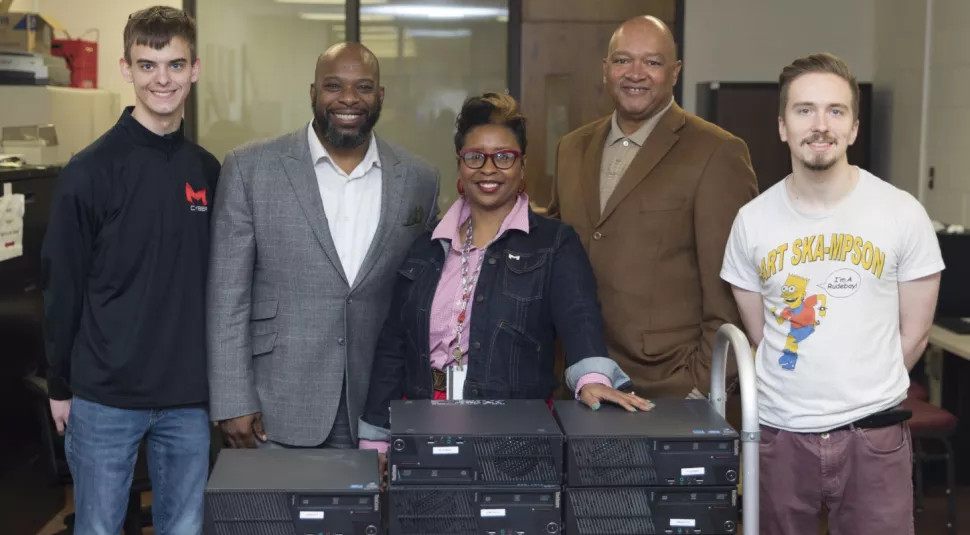4 Ways to Close the Digital Divide by Partnering with Communities, Businesses, and Nonprofits
Closing the digital divide continues to be a priority at many higher ed institutions

Across the country, colleges have been coming up with unique ways to get technology, internet access, and other resources to students. Here are four great examples of how higher education is working with local and national partners to close the digital divide.
1. Donate technology to fill the STEM pipeline
This past April, leaders at Maryville University in St. Louis, Missouri, delivered 22 refurbished computers to the Mathews-Dickey Boys’ & Girls’ Club) as part of its Tech Bar initiative. The devices will allow the organization to expose its boys and girls to coding, cyber technology, and data science.
“We are committed to serving as a community resource,” says Stacy Hollins, Ph.D., associate professor of information systems at Maryville. “Through the Tech Bar, our students provide services to nonprofit organizations and individuals who have limited or no access to technology hardware, software, and training.”
The Tech Bar, which is part of Maryville’s Cyber Fusion Center [see “How It’s Done: Hands-On Cybersecurity Training”], allows students to develop technology skills and work on projects with the local community.
2. Start a targeted fundraising program
“As UMass Boston prepared to go into shutdown mode earlier this year, we learned that a lot of our students had no computers or access,” says Raymond V. Lefebvre, vice chancellor and chief information officer. “We had to do something quick!”
Lefebvre arranged to purchase Chromebooks at $188 each (“A great price!” he says). During a cabinet meeting, one of his colleagues in university advancement suggested asking alumni to donate. “It was ingenious. Within two weeks we’d raised enough money to buy 200 Chromebooks,” says Lefebvre.
The student affairs office polled students to see who needed devices and posted an online form in which students could request a loaner device. Lefebvre’s staff got the Chromebooks prepped and ready, and the public safety department handed out the devices in March.
Tools and ideas to transform education. Sign up below.
“Students returned the laptops at the end of the semester, and I plan to start a Chromebook loaner program on campus in the fall,” says Lefebvre. “Luckily, we already have 200 in the pool to kick it off.”
3. Support at-risk students with an online marketplace
Before the pandemic, California State University Northridge (CSUN) students were already using a secure app called Matador Exchange (from Modo Marketplace) to buy and sell everything from bicycles and mattresses to lamps and textbooks to math tutoring services.
Once quarantine hit, college leaders learned that one in four students in the California State system face food insecurity, so a hub was added to the Matador Exchange that allows students to donate or swap school supplies and home goods.
“Matador Exchange supports vulnerable student communities by letting them exchange goods and services within the campus community,” says Clayton Scott, sustainability coordinator at CSUN. “There’s immediate trust because you have to use a student ID to log in.”
When charitable organizations such as the local food bank donate items to the college, the sustainability office makes the donations available for free. For example, in February 2020, students claimed more than two dozen donated items.
4. Delivering WiFi on demand
In early March, to begin preparing for remote learning, California’s Cypress College surveyed students to determine their technology needs for continuing studies remotely. College administrators discovered that that 400 students (12 percent of the respondents) did not have reliable internet access, 266 students did not have access to a computer, and 999 students did not have a private space at home to conduct their classwork.
Leaders used the data collected to loan three dozen laptops and Chromebooks to students, to connect students to free and low-cost internet opportunities, and to provide $12,000 in emergency grants to help students who lost jobs or experienced income loss.
Next up? A “Drive-Up WiFi” program.
In one of its parking lots, registered Cypress students with valid login credentials could get free internet access on a first-come, first-served basis. The WiFi was available on weekdays from 7:30 am until 10 pm (Monday through Thursday) or 5pm (Friday).
Students were asked to park in every-other parking stall, remain in their cars, and adhere to all public health rules.
